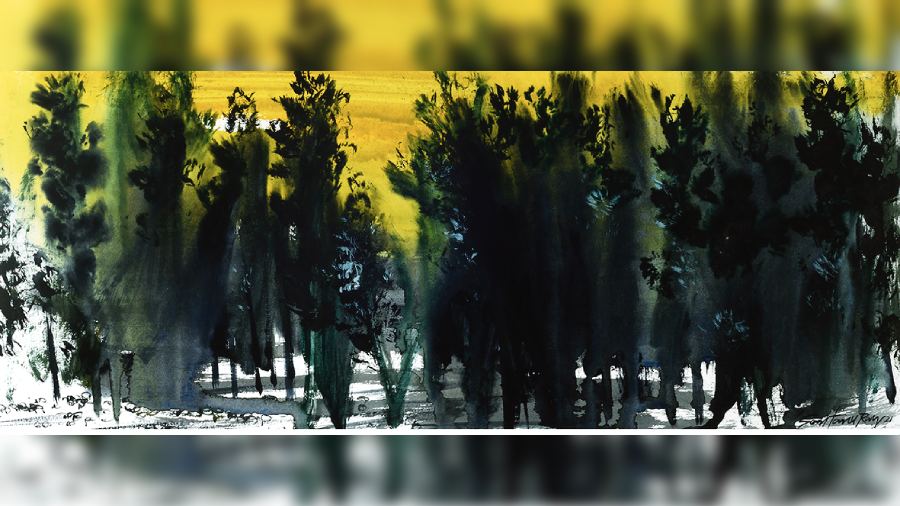Lest one dismiss watercolour as child’s play, let one be warned: it’s as treacherous in its flow and accidental plops as water is, and as difficult to control. Yet its translucence can spell magic and its versatility can coax a range of nuances from a supple brush. This is seen in Watercolours, CIMA’s current show of seven young artists, on till April 30.
If a misted evanescence beckons in Sandip Roy’s landscapes, Sadakul Islam plays up the tangible body of the medium, before letting it peter off into fading peripheries. If subaltern sympathy inspires Satyaranjan Das into chronicling the stoical acceptance of the toil and trials of labourers with minute details, the same concern makes Babli Paul test the fluent transparency of watercolour. While its depth and density are varied with chaotic abandon by Santanu Roy, Ankan Bandyopadhyay brings into it a pensive undertone and Prabhakar Singha with his artful technique seems to make wash both deceptively impervious and delicately porous.
Sandip Roy’s ease with watercolour is seen in his handling of fairly large paintings — 60”X40” — that are often pervaded by an idyllic calm. The barren beauty of Purulia, for example, comes across in gently graded liquid tints of lemon and brown in a series of four scenes. For Santanu Roy, though, landscapes aren’t an escapist’s Eden but tremulous premonitions of a clairvoyant Cassandra. Frenzied slashes, jabs, flakes, shooting sprays, sweeping lateral strokes and scattered scribbles, all in black — impenetrable, vaporous or brittle — script agitations of the earth. The skies are often yellow or grey and impasto smudges of red and blinks of purple and green are there, too. But it is the interludes of the white paper base that charge the dark tones with irrepressible dynamism.
Islam’s robust cattle, although portrayed with photographic fidelity, exist in a vacuum, as it were, for they have been excerpted from their natural surroundings, and thus appear symbolic: a herd is a unified whole that has a collective mind rather than a collection of minds. Das, too, is faithful to verisimilitude in depicting the forbearance of the toiler. To translate in visual terms the epic endurance of migrants during the pandemic, the artist resorts to a sequence of 12 montages in Phenomenon, inserting small figures with a few variations. That brings alive their endless trudge over long, weary, stressful miles. Paul, by contrast, needs no human presence to suggest life on the fringes in Shelter II. This set of 12 cameos of squalor articulates both an edgy vulnerability and a combative resilience.
Bandyopadhyay, however, takes the vulnerability of the lone individual beyond socio-economic prescriptions in paintings where the surreal is embedded in the real. Tiny figures are lost and forlorn whether in a well-appointed new flat or on a Costly Bedcover that has a design of lines resembling topo sheets because the unfamiliar, even if innocuous, may become vast, intimidating alien territory to a Proustian sensibility. Teasing watercolour into an arid, rugged, sooty terrain works well as a correlative of the trauma of quarantine. But while that has an immediate trigger, desolation as a permanent state of mind is what Balcony insinuates.
Finally, there’s a mélange of heads by Singha. Tenuous touches of dark tones against even coats of red evoke intriguing heads, including an animal’s. Shorn of substance and dimension, these fade-in mirages yet pack in revealing particulars: of age, race, personality and mood. Mouths wide open, teeth glinting white, they laugh, scream or snarl, in amusement perhaps, or ridicule or even anger, carrying their creator’s wry, macabre humour.











